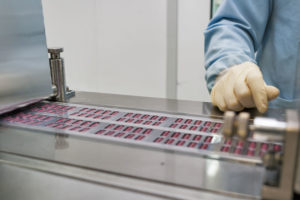Shark Tank for Scientists: NIH’s SBIR/STTR Grants
Have you ever searched for something in NIH RePORTER and seen some unusual grantee organizations in the results, maybe ones with “Inc.” or “LLC” in the name rather than “University” or “Medical Center”? If so, you’ve come across grants made to small businesses through the SBIR/STTR programs.

Go from idea to production with SBIR/STTR funding.
The federal government’s Small Business Innovation Research (SBIR) and Small Business Technology Transfer (STTR) programs grant over $1 billion per year to businesses in the private sector commercializing biomedical technologies, drugs, and devices. Five agencies participate: HHS (NIH), DOD, DOE, NSF, and NASA. Relevant to academic researchers is that the SBIR program encourages, and the STTR program requires, that these small businesses collaborate with a non-profit research institution. These mechanisms tend not to be first in most PIs’ minds, and as a result, at some institutes the paylines are fairly high. For example, in FY2017, the success rate for STTRs at NIMH was 48%. (Use NIH’s Data Book to view success rates for your institute.) Amount of funds per grant varies according to the science, but can be up to $1,710,531 over two years.
I sat down with Robert Freundlich, MD, who recently sat on two study sections for these grants. He told me what these grants are all about and why you might want to collaborate with a small business to apply for one.
What Kind of Science Do They Fund?
SBIR/STTR grants differ from traditional NIH research grants by having commercial potential. Rather than the publications and further grant applications that define success for R01s, the end goal for these grants is to bring a product to market. “Product” is broadly defined and can include devices like artificial joints or implantable monitors, clinical equipment like improved blood testing or imaging units, and drugs. The company that receives the grant can also market and sell the product, or the PIs can sell it to another commercial entity that will bring it to market.
NIH defines two phases for these grants. Phase I is more exploratory, including high-risk-high-reward aims. If you have an idea for a new device, but don’t know if it will work and need some funding to test it, you have a Phase I idea. Phase II projects have solid scientific foundations (i.e., the device definitely works) and now need to continue validation, scale up production, and/or request regulatory approval from the FDA or other agency. Phase II grants are only made to projects that have received a Phase I grant.
As with more familiar grants like R01s, NIH has topics they really want to spend SBIR/STTR money on. Right now, hot topics include opioid addiction and personalized medicine, among others. (NIH’s current medical research initiatives.) If your work fits into one of these initiatives or special focus areas, it may better your chance of getting funded.
Format
 SBIR/STTR grants are structured and reviewed largely like R01s, with an overall impact score and scores for significance, investigator(s), innovation, approach, and environment. The business plan should be integrated with the research plan. For a Phase I application, this might mean a “future directions” or “planned Phase II” section explaining that upon completion of Phase I, you will move from prototype to production, request regulatory approval, or start selling the device. Phase II applications often include sections detailing methods of production, marketing plans, expected revenue stream, or other commercialization plans.
SBIR/STTR grants are structured and reviewed largely like R01s, with an overall impact score and scores for significance, investigator(s), innovation, approach, and environment. The business plan should be integrated with the research plan. For a Phase I application, this might mean a “future directions” or “planned Phase II” section explaining that upon completion of Phase I, you will move from prototype to production, request regulatory approval, or start selling the device. Phase II applications often include sections detailing methods of production, marketing plans, expected revenue stream, or other commercialization plans.
These grants allow for and encourage a much more diverse roster of collaborators than is typical for R01s. For SBIRs, the PI must be employed by a small business; for STTRs, the PI can be employed by a small business or the collaborating academic institution. (Other requirements for splitting the work between the collaborating entities.) For both types, applications are strengthened by including private sector investigators who understand how to commercialize a product. Also important is to clearly explain who is doing what with the project and how that person’s specific background has given him or her the ability to do their part. For example, if you’re an Assistant Professor with no experience in industry, describe how your co-investigator, the COO from your collaborating small business, who has brought several products to market, is going to guide the commercialization aspects of the grant.
Study Section
No standing study sections exist for these grants; all are ad hoc special emphasis panels. Reviewers range from researchers at academic institutions, to small biotech business CEOs, to federal regulators. Panel members work in a variety of areas from basic to translational or clinical to computer science, unlike study sections you may have encountered where all the members are, say, pulmonologists doing basic science in wet labs. One panel Dr. Freundlich sat on had only two physicians in the whole group.
When writing an application, keep in mind that while reviewers have some scientific background, it’s unlikely to be in your exact area, and they were invited to join the panel because of their expertise in bringing products to market or in federal regulations. Your science must be crystal clear and easy to follow for these people. By that same token, review panels include plenty of folks who will know if there’s a market for a device or drug like yours, and have experience bringing products to market, so your business plan should be solid too.
One way to learn a lot about these grants in a very short amount of time is to join a review panel through the Early Career Reviewer Program. If chosen to join a SBIR/STTR study section, you’ll see plenty of these grants and learn a lot about how they work and how they’re reviewed. It’s also a great opportunity to network with smart people outside of academia.
FURTHER READING
Sample Applications from NIAID
Why SBIRs are Different from Academic Grants
Home Page ImageSource: https://pixabay.com/photos/shark-animal-hazard-teeth-fish-674867/






0 Comments